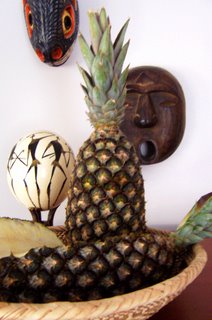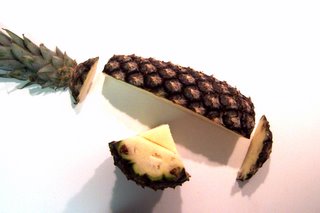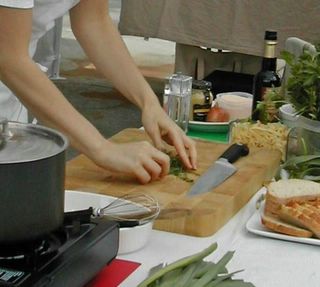Sunday, January 08, 2006
How to Cut Up a Pineapple
.
 There are a lot of ingredients that can intimidate people. I for one, went years without buying any whole crabs because I didn't want to have one and not know what to do with it. The solution in that case was the ever wonderful resource
There are a lot of ingredients that can intimidate people. I for one, went years without buying any whole crabs because I didn't want to have one and not know what to do with it. The solution in that case was the ever wonderful resource
Fish and Shellfish by James Peterson. Pictures and a detailed description explained each and every little step. I was a new woman.
by James Peterson. Pictures and a detailed description explained each and every little step. I was a new woman.
Nowadays, the handy-dandy internet would have yielded the answer. Perhaps you are on this site right now to answer a question yourself, and maybe that question is...what on earth do I do with this pineapple?
Well kiddies, if that is why you are here, it's your lucky day because I'm going to tell you.
But I'm going to make you wait for it while I chitter chat about the pineapples I used. I found them in the market today and was sort of excited because I had never seen anything like them. They are taller, thinner and darker colored (on the outside) than the jet-sweet (jet-fresh? I forget) right from the Hawaiian Dole plantation pineapple I am used to seeing. They were actually from Ghana, Africa. I was so intrigued (and at $0.99 each!) I bought three. The flesh is almost white and the taste is much less perfumed, they are remarkably less stringy, have lower acidity and are much sweeter than more common varieties. I thought cutting them up was a much less daunting task than with a larger fruit, and the resulting 2 cups from one pineapple was perfect. No need to over indulge, and nothing ended up in my freezer.
So, how DID I cut up my perfect Royal African Sugarloaf pineapple? I'll tell you.
 First, get out a large knife.
First, get out a large knife.
Slice 1/4 inch of the bottom off, and then do the same for the top. Discard. (Compost is nice.)
On this particular pineapple, the leaves had a saw-like sharpness, so do be careful if you find them too.
Next, stand the pineapple up on it's now flat base and slice away the rind, following the curve of the fruit. (Much like I did with this orange.) There will for sure be some"eyes" left behind...just cut them off too. (In the picture there I left the rind on, I thought it made it easier to see what was going on...but for sure slice off the rind before proceeding.)
Next, cut down through the center, to create two halves. Lay these down on your board and slice again, lengthwise, creating quarters. Stand each quarter up and notice there is a core. Slicing downward again, remove the core (see in the picture, where the cut is on the slice you are looking down at? That's what I mean.) Discard the cores (or use to infuse vodka) and slice the remaining portions in half.
Cut the remaining pineapple into slices, or chunks and enjoy.
The other option is to use a pineapple corer, but, well, I haven't got room in my house for such a single subject item, have you?
Tomorrow, I will share a recipe I made using this fresh treat!
______________________________________
The major fruit and vegetable growing areas in Ghana, presently concentrated within southern Ghana, are endowed with very favourable climate, deep rich soils and a remarkably knowledgeable rural agricultural labour force. This excellent combination of essential factors make the growing areas ideal for the production of top quality tropical fruits and vegetables. Ghana exports high quality pesticide-free produce. Currently exported products include pineapples, papayas, bananas, mangoes, chillies, tinda, karela, tindori, marrow and many others. - Ghana Trade.org
Pineapples were first cultivated by the Guarani Indians of Brazil and Paraguay. Most languages of the world adopted the word for pineapple from the Brazilian Tupi Indian word "nana" or "anana" (meaning excellent fruit), and not from the name "piña" (pine cone), which the first Spanish explorers gave it. Ananas is the name in French, Italian, Russian, Polish, Serbo-Croat, Romanian, Bulgarian, Turkish, Hebrew and Hindi.
Golden Pineapple is a variety developed by Del Monte in Hawaii. It is not only sweeter, but also contains three times more vitamin C than other pineapples.
 There are a lot of ingredients that can intimidate people. I for one, went years without buying any whole crabs because I didn't want to have one and not know what to do with it. The solution in that case was the ever wonderful resource
There are a lot of ingredients that can intimidate people. I for one, went years without buying any whole crabs because I didn't want to have one and not know what to do with it. The solution in that case was the ever wonderful resourceFish and Shellfish
Nowadays, the handy-dandy internet would have yielded the answer. Perhaps you are on this site right now to answer a question yourself, and maybe that question is...what on earth do I do with this pineapple?
Well kiddies, if that is why you are here, it's your lucky day because I'm going to tell you.
But I'm going to make you wait for it while I chitter chat about the pineapples I used. I found them in the market today and was sort of excited because I had never seen anything like them. They are taller, thinner and darker colored (on the outside) than the jet-sweet (jet-fresh? I forget) right from the Hawaiian Dole plantation pineapple I am used to seeing. They were actually from Ghana, Africa. I was so intrigued (and at $0.99 each!) I bought three. The flesh is almost white and the taste is much less perfumed, they are remarkably less stringy, have lower acidity and are much sweeter than more common varieties. I thought cutting them up was a much less daunting task than with a larger fruit, and the resulting 2 cups from one pineapple was perfect. No need to over indulge, and nothing ended up in my freezer.
So, how DID I cut up my perfect Royal African Sugarloaf pineapple? I'll tell you.
 First, get out a large knife.
First, get out a large knife.Slice 1/4 inch of the bottom off, and then do the same for the top. Discard. (Compost is nice.)
On this particular pineapple, the leaves had a saw-like sharpness, so do be careful if you find them too.
Next, stand the pineapple up on it's now flat base and slice away the rind, following the curve of the fruit. (Much like I did with this orange.) There will for sure be some"eyes" left behind...just cut them off too. (In the picture there I left the rind on, I thought it made it easier to see what was going on...but for sure slice off the rind before proceeding.)
Next, cut down through the center, to create two halves. Lay these down on your board and slice again, lengthwise, creating quarters. Stand each quarter up and notice there is a core. Slicing downward again, remove the core (see in the picture, where the cut is on the slice you are looking down at? That's what I mean.) Discard the cores (or use to infuse vodka) and slice the remaining portions in half.
Cut the remaining pineapple into slices, or chunks and enjoy.
The other option is to use a pineapple corer, but, well, I haven't got room in my house for such a single subject item, have you?
Tomorrow, I will share a recipe I made using this fresh treat!
______________________________________
The major fruit and vegetable growing areas in Ghana, presently concentrated within southern Ghana, are endowed with very favourable climate, deep rich soils and a remarkably knowledgeable rural agricultural labour force. This excellent combination of essential factors make the growing areas ideal for the production of top quality tropical fruits and vegetables. Ghana exports high quality pesticide-free produce. Currently exported products include pineapples, papayas, bananas, mangoes, chillies, tinda, karela, tindori, marrow and many others. - Ghana Trade.org
Pineapples were first cultivated by the Guarani Indians of Brazil and Paraguay. Most languages of the world adopted the word for pineapple from the Brazilian Tupi Indian word "nana" or "anana" (meaning excellent fruit), and not from the name "piña" (pine cone), which the first Spanish explorers gave it. Ananas is the name in French, Italian, Russian, Polish, Serbo-Croat, Romanian, Bulgarian, Turkish, Hebrew and Hindi.
Golden Pineapple is a variety developed by Del Monte in Hawaii. It is not only sweeter, but also contains three times more vitamin C than other pineapples.
Labels: Gluten Free, Kitchen Project, Something Else, Vegan, Vegetarian
Comments:
<< Home
Post a Comment
I know, single-use itemss are a pain.. however, I really do love my pineapple slice thingie. I got it for free from Dole, it's plastic, and it works beautifully, every single time. And it's pretty small. Still, I have a really large drawer full of "weird kitchen gadgets"...
Anne - Ive used them for sure, I just dont buy pineapples often enough to justify it. Cool that you use yours though, I love that!
And Anon - Im not really sure what you are asking. The only things behind the pineapple are two masks and a painted Ostrich egg. I forget where the masks came from (gifts from my father, he collects them) but the egg I got in So. Africa. I hope that answers your question!
Post a Comment
And Anon - Im not really sure what you are asking. The only things behind the pineapple are two masks and a painted Ostrich egg. I forget where the masks came from (gifts from my father, he collects them) but the egg I got in So. Africa. I hope that answers your question!
<< Home
<< Home


